Historical Trends and Variability in Heat Waves in the United Kingdom
Abstract
:1. Introduction
2. Experiments
2.1. Selection of Stations
2.2. Pre-Processing of Station Data
2.3. Definitions of Hot Days and Heat Waves
2.4. Analysis of Trends
2.5. Ocean and Atmospheric Indices
2.6. Logistic Regression across Multiple Stations
3. Results
3.1. Analysis of First and Last Heat Wave Days
3.2. Heat Wave Characteristics
3.3. Trends in Heat Waves
3.4. Variations in the AMO, Summertime NAO and Heat Wave Characteristics
3.4.1. Effects on Numbers of Heat Waves
3.4.2. Logistic Modelling of Heat Wave Lengths
4. Discussion
4.1. Heat Wave Metrics
4.2. Circulation and SST Influences
4.3. Limitations and Further Work
5. Conclusions
Supplementary Materials
Acknowledgments
Author Contributions
Conflicts of Interest
Appendix A
Locations and Data Periods of the 29 Weather Stations Selected for Study
| Station Name | Latitude | Longitude | Country a | Data From |
|---|---|---|---|---|
| Aldergrove | 54.6636 | −6.22436 | NI | 1930 |
| Armagh | 54.3523 | −6.64866 | NI | 1865 |
| Balmoral | 57.0375 | −3.21897 | SCO | 1918 |
| Bradford | 53.8134 | −1.77234 | ENG | 1908 |
| Cambridge, Botanic Gardens | 52.1935 | 0.13113 | ENG | 1911 |
| Craibstone | 57.1868 | −2.21323 | SCO | 1931 |
| Cranwell | 53.0309 | −0.50194 | ENG | 1930 |
| Cromer | 52.9332 | 1.29273 | ENG | 1902 |
| Douglas | 54.168 | −4.48022 | IOM | 1878 |
| Durham | 54.7679 | −1.58455 | ENG | 1880 |
| Eastbourne | 50.7617 | 0.28543 | ENG | 1911 |
| Lerwick | 60.1395 | −1.18299 | SCO | 1930 |
| Leuchars | 56.3775 | −2.86051 | SCO | 1921 |
| London, St James’s Park | 51.5043 | −0.12948 | ENG | 1903 |
| Morecambe No 2 | 54.0762 | −2.85825 | ENG | 1930 |
| Morpeth, Cockle Park | 55.2129 | −1.68615 | ENG | 1897 |
| Newton Rigg | 54.6699 | −2.78644 | ENG | 1906 |
| Oxford | 51.7607 | −1.2625 | ENG | 1853 |
| Plymouth Mountbatten b | 50.3544 | −4.11986 | ENG | 1874 |
| Rothamsted | 51.8062 | −0.35858 | ENG | 1916 |
| Sheffield | 53.38128 | −1.48986 | ENG | 1882 |
| Shoeburyness b | 51.53606 | 0.80914 | ENG | 1930 |
| Skegness | 53.1476 | 0.34797 | ENG | 1904 |
| Stornoway Airport | 58.2138 | −6.31772 | SCO | 1873 |
| Teignmouth | 50.5451 | −3.49487 | ENG | 1931 |
| Tiree | 56.49982 | −6.8796 | SCO | 1930 |
| Valley | 53.2524 | −4.53524 | WAL | 1930 |
| Wick Airport | 58.4541 | −3.0884 | SCO | 1930 |
| Wisley | 51.3103 | −0.47478 | ENG | 1904 |
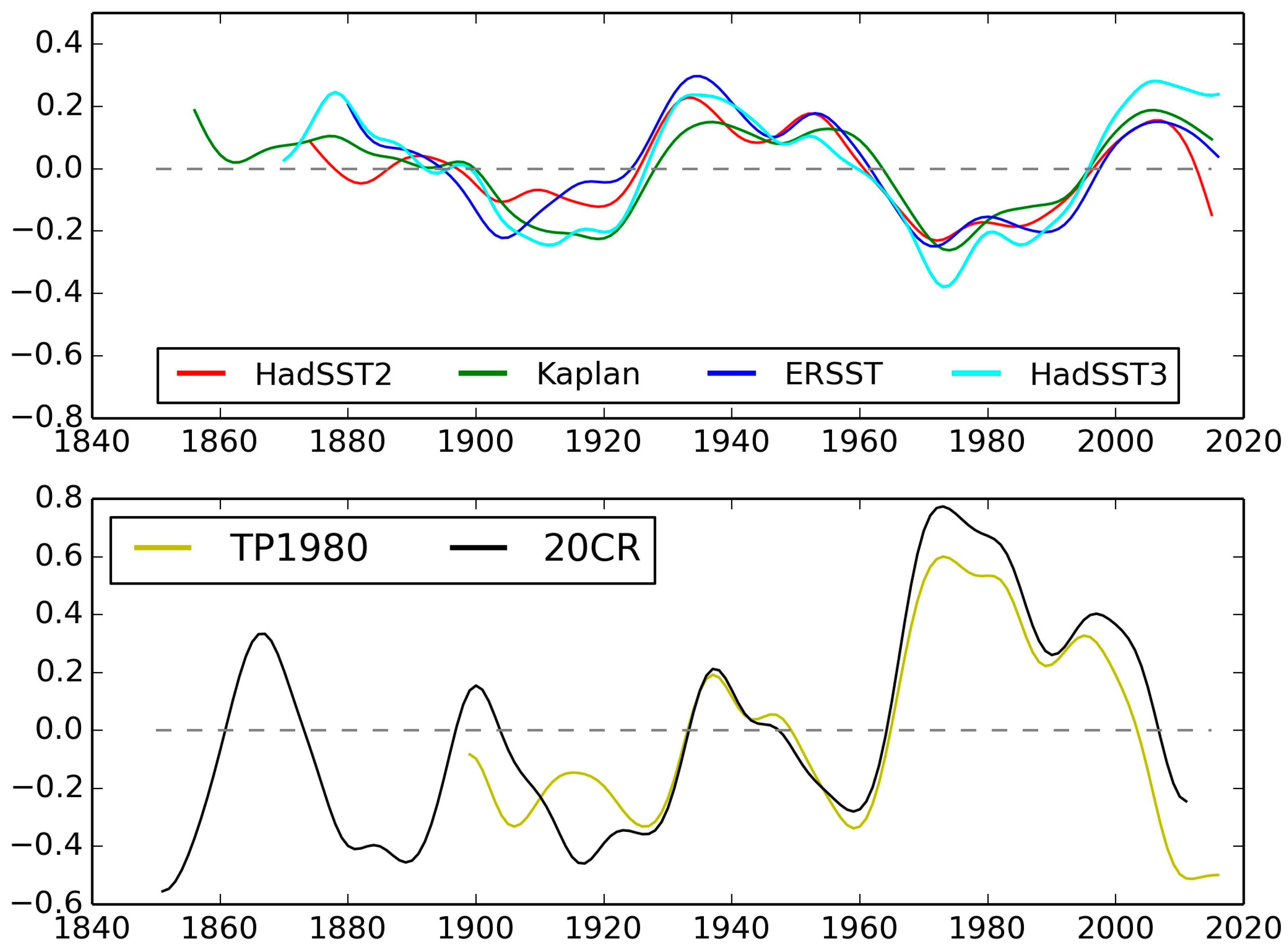

References
- D’Ippoliti, D.; Michelozzi, P.; Marino, C.; de’Donato, F.; Menne, B.; Katsouyanni, K.; Kirchmayer, U.; Analitis, A.; Medina-Ramón, M.; Paldy, A.; et al. The impact of heat waves on mortality in 9 European cities: Results from the EuroHEAT project. Environ. Health 2010, 9, 37. [Google Scholar] [CrossRef] [PubMed]
- Dobney, K.; Baker, C.J.; Quinn, A.D.; Chapman, L. Quantifying the effects of high summer temperatures due to climate change on buckling and rail related delays in south-east United Kingdom. Meteorol. Appl. 2009, 6, 245–251. [Google Scholar] [CrossRef]
- Van Vliet, M.T.H.; Ludwig, F.; Zwolsman, J.J.G.; Weedon, G.P.; Kabat, P. Global river temperatures and sensitivity to atmospheric warming and changes in river flow. Water Resour. Res. 2011, 47, W02544. [Google Scholar] [CrossRef]
- Johnk, K.D.; Huisman, J.; Sharples, J.; Sommeijeri, B.; Visser, P.M.; Strooms, J.M. Summer heat-waves promote blooms of harmful cyanobacteria. Glob. Chang. Biol. 2008, 14, 495–512. [Google Scholar] [CrossRef]
- Della-Marta, P.M.; Haylock, M.R.; Luterbacher, J.; Wanner, H. Doubled length of western European summer heat waves since 1880. J. Geophys. Res. 2007, 112. [Google Scholar] [CrossRef] [Green Version]
- Labajo, Á.L.; Egido, M.; Martin, Q.; Labajo, J.; Labajo, J.L. Definition and temporal evolution of the heat and cold waves over the Spanish Central Plateau from 1961 to 2010. Atmósfera 2014, 27, 273–286. [Google Scholar] [CrossRef]
- Brugnara, Y.; Auchmann, R.; Brönnimann, S.; Bozzo, A.; Berro, D.C.; Mercalli, L. Trends of mean and extreme temperature indices since 1874 at low-elevation sites in the southern Alps. J. Geophys. Res. Atmos. 2016, 121, 3304–3325. [Google Scholar] [CrossRef]
- Bartoszek, K.; Krzyżewska, A. The atmospheric circulation conditions of the occurrence of heatwaves in Lublin, southeast Poland. Weather 2016, 72, 176–180. [Google Scholar] [CrossRef]
- Morabito, M.; Crisci, A.; Messeri, A.; Messeri, G.; Betti, G.; Orlandini, S.; Raschi, A.; Maracchi, G. Increasing heatwave hazards in the southeastern European Union capitals. Atmosphere 2017, 8, 115. [Google Scholar] [CrossRef]
- Shevchenko, O.; Lee, H.; Snizhko, S.; Mayer, H. Long-term analysis of heat waves in Ukraine. Int. J. Climatol. 2014, 34, 1642–1650. [Google Scholar] [CrossRef]
- Beniston, M. The 2003 heat wave in Europe: A shape of things to come? An analysis based on Swiss climatological data and model simulations. Geophys. Res. Lett. 2004, 31, L02202. [Google Scholar] [CrossRef]
- Parker, D.E.; Horton, E.B. Uncertainties in the Central England Temperature series since 1878 and some changes to the maximum and minimum series. Int. J. Climatol. 2005, 25, 1173–1188. [Google Scholar] [CrossRef]
- Hulme, M.; Jenkins, G.J.; Lu, X.; Turnpenny, J.R.; Mitchell, T.D.; Jones, R.G.; Lowe, J.; Murphy, J.M.; Hassell, D. Climate Change Scenarios for the United Kingdom: The UKCIP02 Scientific Report; Tyndall Centre for Climate Change Research, School of Environmental Sciences, University of East Anglia: Norwich, UK, 2002; p. 120. [Google Scholar]
- Perkins, S.E.; Alexander, L.V. On the measurement of heat waves. J. Clim. 2013, 26, 4500–4517. [Google Scholar] [CrossRef]
- Knight, J.R.; Folland, C.K.; Scaife, A.A. Climate impacts of the Atlantic Multidecadal Oscillation. Geophys. Res. Lett. 2006, 33, L17706. [Google Scholar] [CrossRef]
- Chylek, P.; Klett, J.D.; Lesins, G.; Dubey, M.K.; Hengartner, N. The Atlantic Multidecadal Oscillation as a dominant factor of oceanic influence on climate. Geophys. Res. Lett. 2014, 41, 1689–1697. [Google Scholar] [CrossRef]
- Della-Marta, P.M.; Luterbacher, J.; von Weissenfluh, H.; Xoplaki, E.; Brunet, M.; Wanner, H. Summer heat waves over western Europe 1880–2003, their relationship to large-scale forcings and predictability. Clim. Dyn. 2007, 29, 251–275. [Google Scholar] [CrossRef]
- Cropper, T.; Cropper, P.A. 133-year record of climate change and variability from Sheffield, England. Climate 2016, 4, 46. [Google Scholar] [CrossRef]
- Folland, C.K.; Knight, J.; Linderholm, H.W.; Fereday, D.; Ineson, S.; Hurrell, J.W. The summer North Atlantic Oscillation: Past, present, and future. J. Clim. 2009, 22, 1082–1103. [Google Scholar] [CrossRef]
- Rust, H.W.; Richling, A.; Bissolli, P.; Ulbrich, U. Linking teleconnection patterns to European temperature—A multiple linear regression model. Meteorol. Z. 2015, 24, 411–423. [Google Scholar] [CrossRef]
- Kenyon, J.; Hegerl, G.C. Influence of modes of climate variability on global temperature extremes. J. Clim. 2008, 21, 3872–3889. [Google Scholar] [CrossRef]
- Zhou, Y.; Wu, Z. Possible impacts of mega-El Niño/Southern Oscillation and Atlantic Multidecadal Oscillation on Eurasian heatwave frequency variability. Q. J. R. Meteorol. Soc. 2016, 142, 1647–1661. [Google Scholar] [CrossRef]
- Met Office Integrated Data Archive System (MIDAS) Land and Marine Surface Stations Data (1853–Current). NCAS British Atmospheric Data Centre. Available online: http://catalogue.ceda.ac.uk/uuid/220a65615218d5c9cc9e4785a3234bd0 (accessed on 27 March 2017).
- Venables, W.N.; Ripley, B.D. Modern Applied Statistics with S, 4th ed.; Springer: New York, NY, USA, 2002. [Google Scholar]
- Van Oldenborgh, G.J.; te Raa, L.A.; Dijkstra, H.A.; Philip, S.Y. Frequency- or amplitude-dependent effects of the Atlantic meridional overturning on the tropical Pacific Ocean. Ocean Sci. 2009, 5, 293–301. [Google Scholar] [CrossRef]
- Enfield, D.B.; Mestas-Nunez, A.M.; Trimble, P.J. The Atlantic Multidecadal Oscillation and its relationship to rainfall and river flows in the continental U.S. Geophys. Res. Lett. 2001, 28, 2077–2080. [Google Scholar] [CrossRef]
- Kennedy, J.J.; Rayner, N.A.; Smith, R.O.; Saunby, M.; Parker, D.E. Reassessing biases and other uncertainties in sea-surface temperature observations since 1850 part 2: Biases and homogenisation. J. Geophys. Res. 2011, 116, D14104. [Google Scholar] [CrossRef]
- Knight, J.R.; Allan, R.J.; Folland, C.K.; Vellinga, M.; Mann, M.E. A signature of persistent natural thermohaline circulation cycles in observed climate. Geophys. Res. Lett. 2005, 32, L20708. [Google Scholar] [CrossRef]
- Trenberth, K.E.; Paolino, D.A. The Northern Hemisphere sea level pressure data set: Trends, errors, and discontinuities. Mon. Weather Rev. 1980, 108, 855–872. [Google Scholar] [CrossRef]
- Compo, G.P.; Whitaker, J.S.; Sardeshmukh, P.D. The Twentieth Century Reanalysis Project. Q. J. R. Meteorol. Soc. 2001, 137, 1–28. [Google Scholar] [CrossRef]
- R Core Team. R: A Language and Environment for Statistical Computing; R Foundation for Statistical Computing: Vienna, Austria, 2016; Available online: https://www.R-project.org/ (accessed on 8 August 2017).
- Plummer, M. Rjags: Bayesian Graphical Models Using MCMC, R Package Version 4-4, 2015. Available online: https://cran.r-project.org/package=rjags (accessed on 30 August 2016).
- IPCC. Summary for Policymakers. In Climate Change 2013: The Physical Science Basis. Contribution of Working Group I to the Fifth Assessment Report of the Intergovernmental Panel on Climate Change; Stocker, T.F., Qin, D., Plattner, G., Tignor, M., Allen, S.K., Boschung, J., Nauels, A., Xia, Y., Bex, V., Midgley, P.M., Eds.; Cambridge University Press: Cambridge, UK; New York, NY, USA, 2013; pp. 1–30. [Google Scholar]
- Vecchi, G.A.; Delworth, T.L.; Booth, B. Climate science: Origins of Atlantic decadal swings. Nature 2017, 548, 284–285. [Google Scholar] [CrossRef] [PubMed]
- Duchez, A.; Frajka-Williams, E.; Josey, S.A.; Evans, D.G.; Grist, J.P.; Marsh, R.; McCarthy, G.D.; Sinha, B.; Berry, D.I.; Hirschi, J.J.-M. Drivers of exceptionally cold North Atlantic Ocean temperatures and their link to the 2015 European heat wave. Environ. Res. Lett. 2016, 11, 074004. [Google Scholar] [CrossRef]
- Frajka-Williams, E.; Beaulieu, C.; Duchex, A. Emerging negative Atlantic Multidecadal Oscillation index in spite of warm subtropics. Sci. Rep. 2017, 7, 11224. [Google Scholar] [CrossRef] [PubMed]
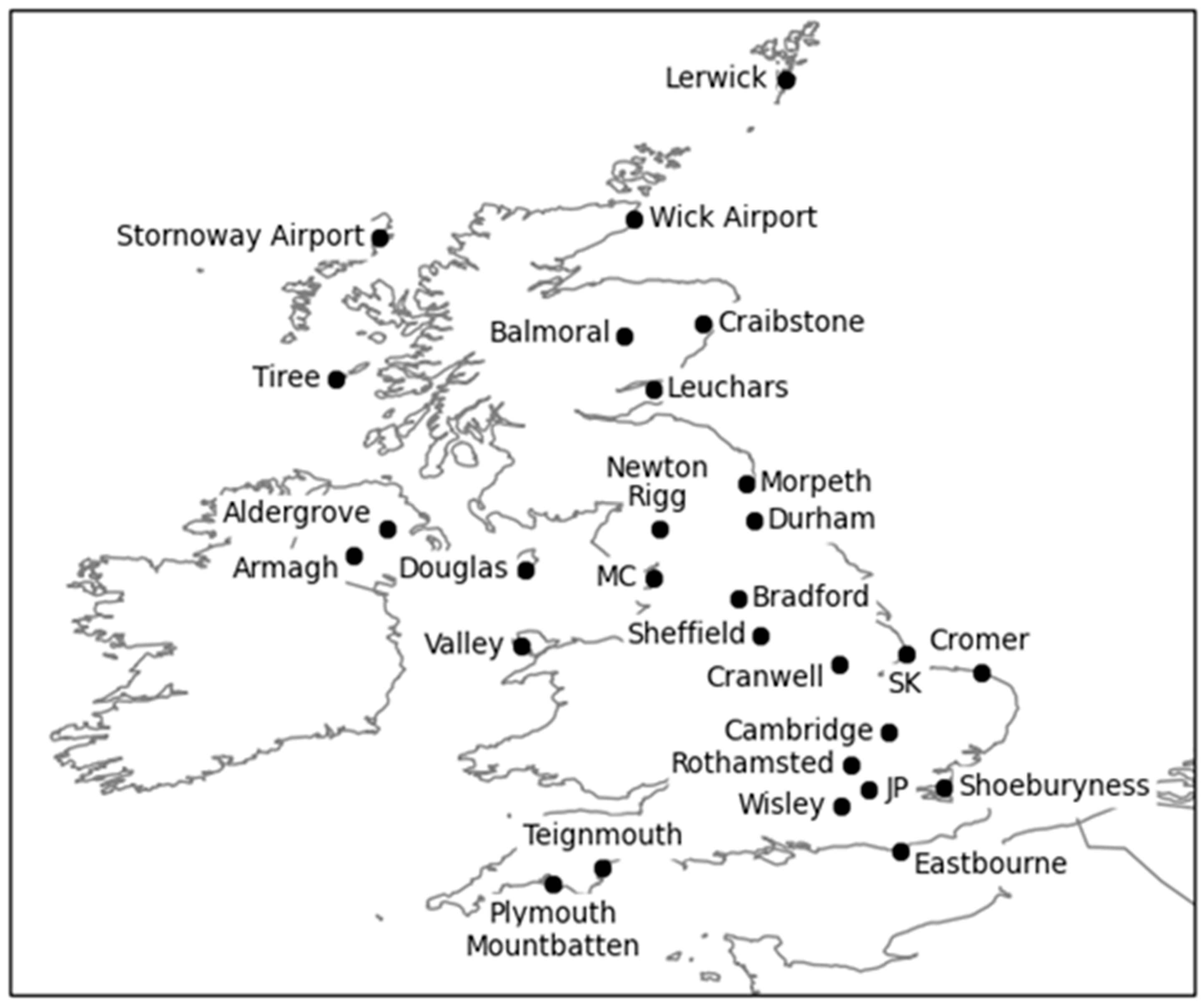
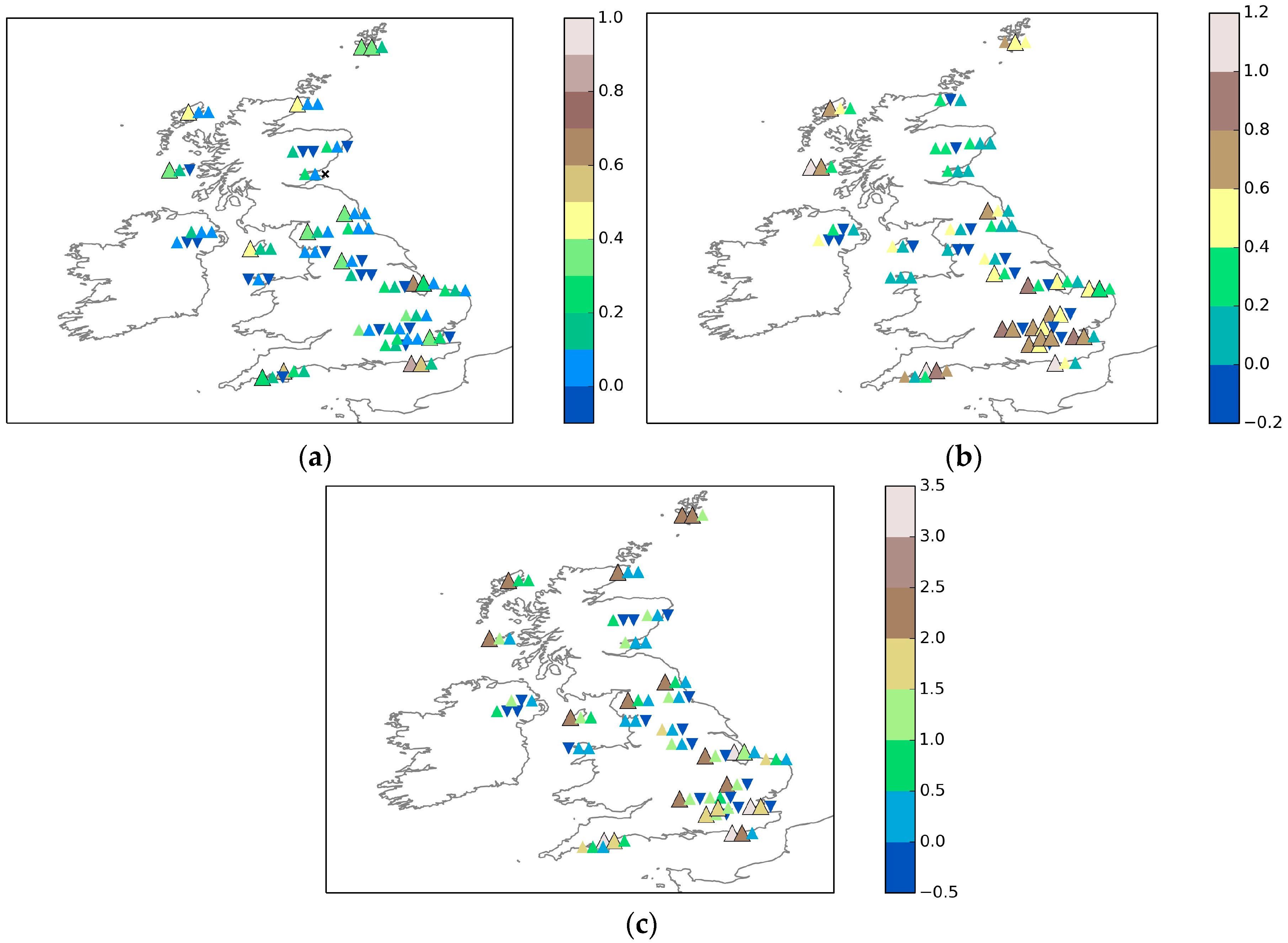


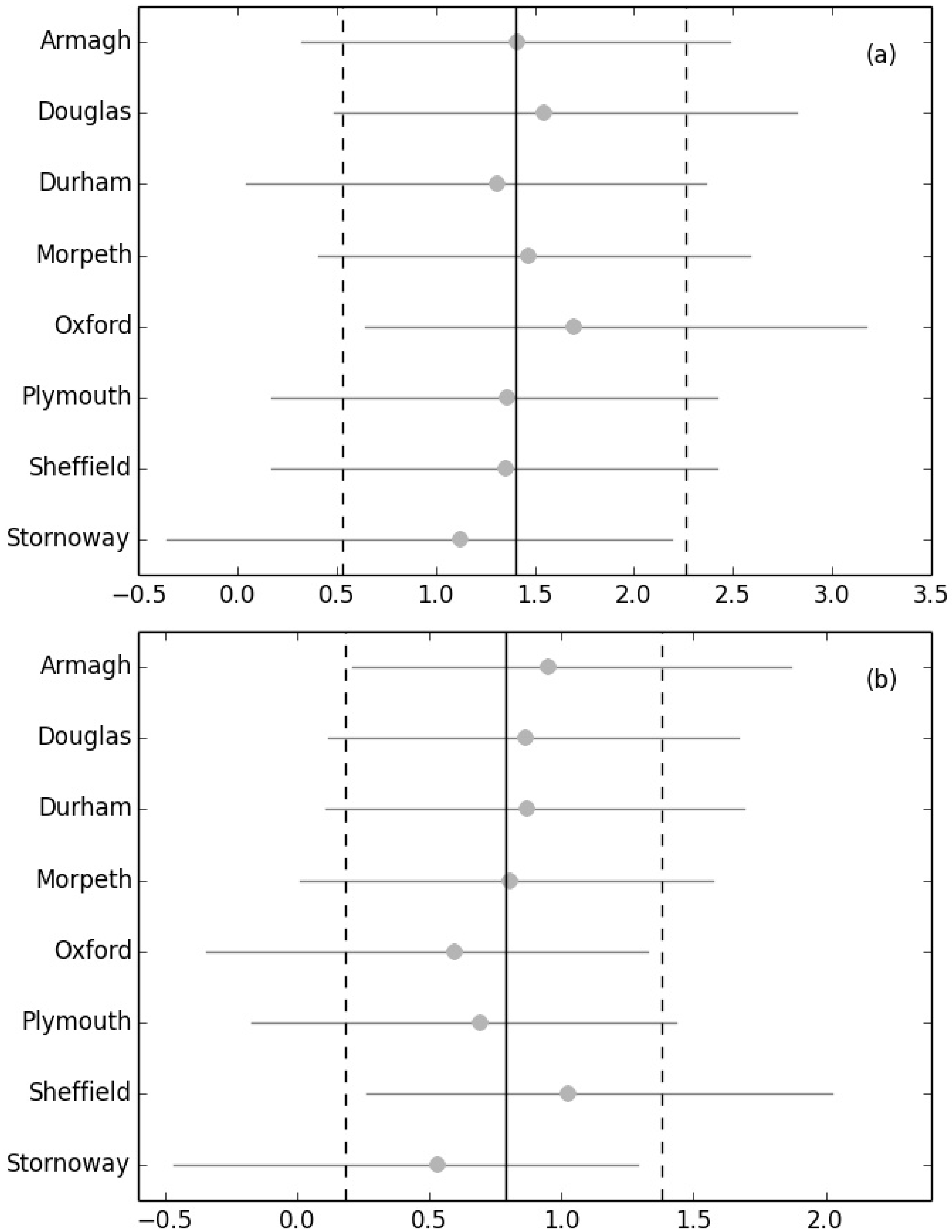
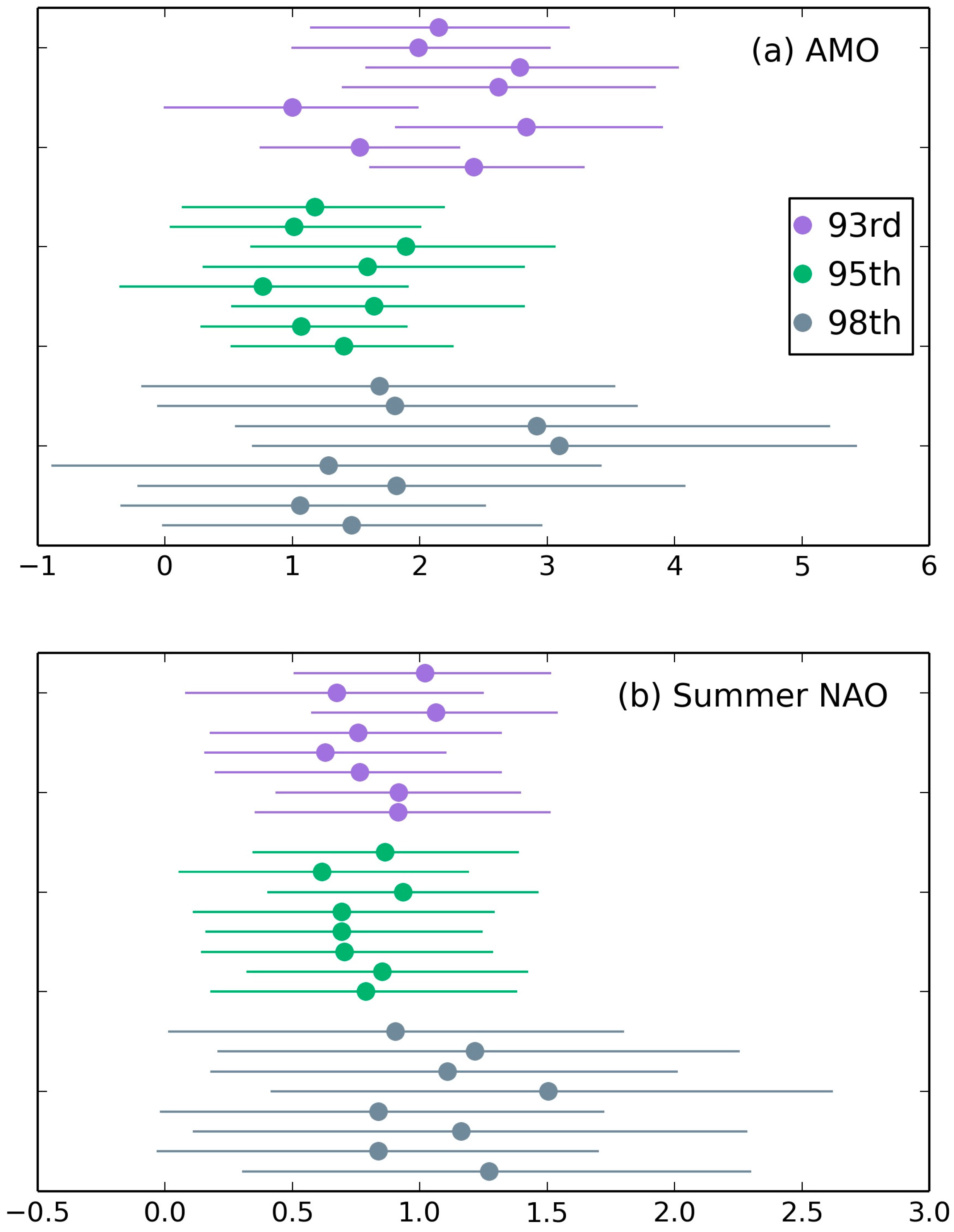
| Station | HWN | HWD | HWF | HWA |
|---|---|---|---|---|
| Aldergrove | 2 [1–3] | 5 [4–7] | 10 [6–14] | 25.2 [24.0–27.2] |
| Armagh | 2 [1–3] | 5 [4–8] | 10 [7–16] | 26.0 [25.0–27.6] |
| Balmoral | 2 [1–3] | 5 [4–7] | 9 [6–14] | 25.6 [24.7–27.5] |
| Bradford | 2 [1–3] | 5 [4–7] | 8 [6–16] | 27.2 [26.1–28.3] |
| Cambridge, Botanical Gardens | 2 [1–3] | 6 [4–7] | 10 [5–15] | 30.6 [29.4–32.4] |
| Craibstone | 2 [1–3] | 5 [3–6] | 9 [4–14] | 24.9 [23.3–25.6] |
| Cranwell | 2 [1–4] | 5 [4–8] | 10 [6–18] | 30.0 [28.6–31.7] |
| Cromer | 2 [2–3] | 4 [3–6] | 10 [6–14] | 29.0 [27.1–30.9] |
| Douglas | 2 [1–4] | 5 [4–8] | 12 [6–18] | 24.4 [22.8–25.5] |
| Durham | 2 [1–4] | 5 [4–7] | 10 [5–17] | 27.2 [25.6–29.0] |
| Eastbourne | 2 [1–4] | 6 [4–8] | 11 [6–18] | 26.5 [25.6–27.8] |
| Lerwick | 2 [2–4] | 6 [4–9] | 12 [7–20] | 18.9 [17.5–20.6] |
| Leuchars | 2 [1–3] | 4 [3–6] | 7 [4–14] | 25.4 [24.4–27.2] |
| London, St James’s Park | 2 [1–4] | 6 [4–8] | 11 [6–17] | 30.9 [29.4–32.8] |
| Morecambe | 2 [2–3] | 5 [4–8] | 10 [6–16] | 27.6 [25.6–28.9] |
| Morpeth | 2 [1–4] | 5 [3–7] | 9 [6–17] | 25.3 [24.4–27.2] |
| Newton Rigg | 2 [1–34] | 6 [4–8] | 11 [7–16] | 27.0 [25.4–28.3] |
| Oxford | 2 [1–3] | 5 [4–8] | 10 [6–16] | 30.0 [28.7–31.6] |
| Plymouth Mountbatten | 2 [1–3] | 5 [4–7] | 9 [5–14] | 25.8 [24.8–27.4] |
| Rothamstead | 2 [1–3] | 5 [4–7] | 10 [6–14] | 29.4 [27.8–30.7] |
| Sheffield | 2 [1–3] | 5 [4–6] | 8 [5–13] | 28.6 [27.7–30.2] |
| Shoeburyness | 3 [2–4] | 5 [4–8] | 12 [6–19] | 28.0 [27.1–29.5] |
| Skegness | 2 [1–3] | 4 [3–6] | 8 [5–13] | 27.2 [25.8–28.4] |
| Stornoway Airport | 3 [1–4] | 6 [4–8] | 14 [7–20] | 22.2 [20.6–23.3] |
| Teignmouth | 2 [1–4] | 5 [3–8] | 10 [6–19] | 25.6 [24.6–27.2] |
| Tiree | 2 [1–3] | 5 [4–9] | 9 [5–17] | 22.4 [20.5–23.8] |
| Valley | 2 [1–3] | 4 [3–8] | 8 [4–7,16] | 27.1 [25.2–28.2] |
| Wick Airport | 2 [1–3] | 4 [3–6] | 7 [4–14] | 21.7 [20.5–22.9] |
| Wisley | 2 [1–4] | 6 [4–8] | 10 [6–17] | 30.6 [29.0–32.2] |
© 2017 by the authors. Licensee MDPI, Basel, Switzerland. This article is an open access article distributed under the terms and conditions of the Creative Commons Attribution (CC BY) license (http://creativecommons.org/licenses/by/4.0/).
Share and Cite
Sanderson, M.G.; Economou, T.; Salmon, K.H.; Jones, S.E.O. Historical Trends and Variability in Heat Waves in the United Kingdom. Atmosphere 2017, 8, 191. https://doi.org/10.3390/atmos8100191
Sanderson MG, Economou T, Salmon KH, Jones SEO. Historical Trends and Variability in Heat Waves in the United Kingdom. Atmosphere. 2017; 8(10):191. https://doi.org/10.3390/atmos8100191
Chicago/Turabian StyleSanderson, Michael G., Theo Economou, Kate H. Salmon, and Sarah E. O. Jones. 2017. "Historical Trends and Variability in Heat Waves in the United Kingdom" Atmosphere 8, no. 10: 191. https://doi.org/10.3390/atmos8100191





